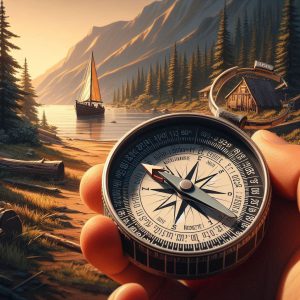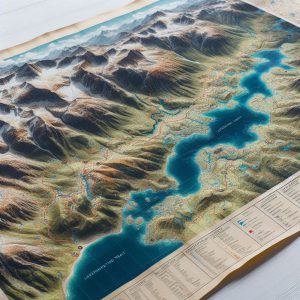Elevate Your Wilderness Navigation Skills: A Step-by-Step Guide for Adventurers Without GPS
Becoming proficient in wilderness navigation devoid of modern gadgets may seem daunting at first, yet mastering fundamental map and compass navigation skills is an invaluable asset that can transform your outdoor experiences. At the core of effective navigation is an in-depth understanding of your natural environment and the capability to ascertain your position relative to your destination. A map serves as a comprehensive two-dimensional representation of the landscape, while a compass provides a reliable method for orienting yourself within the cardinal directions: north, south, east, and west. By refining your skills with these tools, you can embark on outdoor adventures, liberated from reliance on technology.
To embark on your navigation journey, immerse yourself in the diverse symbols and scales depicted on a map; these components are vital for accurately interpreting the terrain. A robust understanding of reading contour lines that indicate elevation changes is crucial, as it allows you to recognize hills, valleys, and other geographical features that may influence your chosen path. Furthermore, developing proficiency in compass usage is equally important, as it enables you to navigate through the wilderness effectively without the aid of GPS technologies.
The compass needle consistently points toward magnetic north, allowing you to align your map with the actual landscape. To accomplish this, hold the compass level and rotate the map until the magnetic north displayed on the compass aligns with the north indicated on the map. This essential process, known as “orienting the map,” is critical for maintaining accuracy in your navigation efforts and ensuring you remain on the right track.
Once the map is properly oriented, you can utilize the compass to take bearings that will guide your travel direction. By effectively integrating these two powerful navigational tools—the map and the compass—you will confidently navigate through unfamiliar terrains, ensuring you remain on course even without modern technological assistance.
Key Principles for Mastering Outdoor Navigation
- Gaining expertise in map and compass navigation is crucial for anyone engaging in wilderness exploration or various outdoor pursuits.
- Topographic maps offer intricate details about the terrain, elevation, and natural features, which are vital for effective navigation.
- A compass not only determines direction but also enhances navigation efficacy by aligning with the map’s orientation and understanding magnetic north.
- Natural landmarks and indicators, such as distinctive rock formations or unique tree arrangements, can serve as valuable navigational aids when a map or compass isn't available.
- Estimating distance and travel time is essential for planning and executing a successful navigation strategy in the wilderness.
 The Crucial Importance of Topographic Maps in Wilderness Navigation
The Crucial Importance of Topographic Maps in Wilderness Navigation
Topographic maps are essential tools for anyone planning an expedition into the wilderness. They provide detailed information regarding the physical characteristics of the terrain, utilizing contour lines to depict changes in elevation. This representation helps you visualize the landscape's shape and steepness, preparing you for the potential challenges that lie ahead. Each contour line connects points of equal elevation, and the proximity of these lines indicates whether the slope is steep or gradual, granting you the essential knowledge required for effective navigation.
Understanding Contour Lines and Map Symbols for Enhanced Navigation
As you explore a topographic map, it's imperative to analyze the patterns created by contour lines; closely spaced lines signify steep terrain, while widely spaced lines indicate flatter areas. This understanding empowers you to anticipate possible obstacles along your route, allowing for informed navigation decisions. Additionally, topographic maps are abundant with symbols representing various landmarks, including rivers, roads, trails, and different types of vegetation. Familiarizing yourself with these symbols is foundational for effective navigation, ensuring you can utilize the map to its maximum potential.
Refining Navigation Techniques Using Topographic Maps
For instance, blue lines typically indicate the occurrence of water bodies, such as streams or lakes, while green areas may represent forests or dense vegetation. By correlating these symbols with your surroundings, you can confirm your location and make necessary adjustments to your route. Moreover, topographic maps often feature grid lines that assist you in identifying coordinates, allowing for even greater precision in navigation. By mastering the intricacies of topographic maps, you will deepen your appreciation for the landscape while enhancing your overall navigational skills in the wild.
 Leveraging the Power of a Compass for Reliable Directional Navigation
Leveraging the Power of a Compass for Reliable Directional Navigation
A compass is an indispensable tool for any adventurer, providing critical assistance in directional navigation, especially when traversing uncharted landscapes. To effectively utilize a compass, begin by holding it level in front of you and allowing the needle to stabilize. The needle will point toward magnetic north, which may slightly differ from true north due to magnetic declination—the angle between magnetic north and true north fluctuates based on your geographical location.
Prior to embarking on your journey, it’s essential to ascertain the local declination and adjust your compass accordingly. This adjustment is crucial for maintaining accurate bearings, ensuring you remain on course throughout your adventure. Once your compass is calibrated for declination, you can proceed to take a bearing that will guide your travel direction.
To take a bearing, identify a landmark you wish to navigate toward, and rotate the compass housing until the orienting arrow aligns with the magnetic needle. The degree reading on the compass dial that aligns with the index line represents your bearing. As you progress toward your destination, routinely check your bearing to ensure you stay on the right path.
If you discover yourself veering off course, reorient your compass and adjust your path as necessary. By mastering these techniques, you will gain confidence in utilizing a compass as a dependable navigational tool during any outdoor adventure.
 Harnessing Natural Landmarks and Signs for Efficient Wilderness Navigation
Harnessing Natural Landmarks and Signs for Efficient Wilderness Navigation
While maps and compasses are fundamental navigational tools, keen observation of natural landmarks and cues can significantly enhance your ability to navigate the wilderness effectively. Distinctive features such as mountains, rivers, or unique trees can serve as critical reference points when traversing unknown terrain. For instance, if you know a particular mountain lies to the east of your starting position, you can use it as a reliable guide to ensure you’re heading in the right direction.
Moreover, familiarizing yourself with the distinctive characteristics of your surroundings will assist in forming mental maps, enabling you to navigate without solely relying on navigational tools. In addition to prominent landmarks, be attentive to natural signs that may indicate direction or changes in terrain. The sun's position can serve as a useful guide; in the northern hemisphere, the sun rises in the east and sets in the west, providing a general sense of direction throughout the day.
Additionally, observing moss growth on trees—often denser on the north side—can offer valuable clues about orientation in dense forests. Animal trails can also provide directional insights; many animals follow established paths that can lead you toward water sources or other significant landmarks. By honing your ability to interpret these natural signs, you will enhance your skills in navigating diverse environments.
Strategically Estimating Distance and Travel Time for Effective Wilderness Navigation
Accurately estimating distance and travel time is crucial for successful navigation in wilderness areas. Understanding how far you've traveled and the anticipated time to reach your destination allows for superior planning and helps circumvent unforeseen challenges. One practical technique for estimating distance is pacing—counting your steps as you walk.
On average, an adult’s stride is approximately 2.5 feet, meaning that by counting your steps over a known distance, you can assess how far you've traveled based on your pace. Additionally, account for the type of terrain and elevation changes when estimating travel time. For example, traversing flat ground generally permits quicker movement compared to navigating steep hills or rocky paths.
A common guideline suggests that you can cover approximately three miles per hour on flat terrain, though this estimate should be adjusted significantly when encountering challenging landscapes. By considering these variables and modifying your expectations accordingly, you will be better prepared for your journey and more adept at managing your time effectively.
Creating a Strategic Wilderness Route and Navigation Plan for Success
Designing Your Wilderness Route for Optimal Navigation
Establishing an effective navigation plan is essential before embarking on any wilderness adventure. Begin by examining topographic maps of the area you intend to explore, pinpointing potential routes based on prominent landmarks, existing trails, and available water sources. As you construct your route, consider factors such as elevation changes and terrain difficulty; ensuring your plan is realistic and achievable is of utmost importance.
Preparing for Unexpected Obstacles and Weather Changes During Your Journey
While planning your route, it’s wise to consider alternative paths in case you encounter unforeseen challenges or abrupt changes in weather conditions. Having multiple options will provide you with greater flexibility during your journey and enhance your overall safety. This adaptability is vital for a successful and enjoyable wilderness experience, empowering you to navigate any challenges that may arise seamlessly.
Crafting a Comprehensive Navigation Strategy for Outdoor Adventures
Once you've mapped out potential routes, develop a detailed navigation plan that includes key waypoints. Mark these waypoints on your map and, if possible, note their coordinates, allowing you to track your progress as you navigate through the wilderness. Additionally, incorporate estimated travel times between waypoints and identify any potential hazards that may arise along your chosen route.
Ensuring a Safe and Rewarding Outdoor Experience Through Preparation
Thorough planning and anticipating challenges greatly enhance your chances of reaching your destination while enjoying a safe and fulfilling outdoor experience. A well-organized navigation strategy is essential for a successful wilderness adventure, ensuring that you can explore the great outdoors with confidence and assurance.
 Implementing Emergency Navigation Techniques for Unforeseen Scenarios
Implementing Emergency Navigation Techniques for Unforeseen Scenarios
Despite meticulous planning and preparation, unexpected circumstances may arise during outdoor adventures that necessitate emergency navigation techniques. One vital skill is the ability to backtrack; if you find yourself lost or disoriented, retracing your steps can often lead you back to familiar territory. To execute this effectively, pay close attention to distinctive landmarks or features along your route, which can serve as reference points when returning.
Another invaluable technique is celestial navigation, particularly useful when visibility permits—especially on clear nights or sunny days when stars or celestial bodies are visible. Familiarizing yourself with prominent constellations, such as the North Star (Polaris) in the northern hemisphere, can provide guidance, as it remains relatively fixed in position while other stars shift. By locating Polaris and determining its angle above the horizon, you can ascertain true north without relying on a compass or map.
If you have a wristwatch or smartphone as a backup, utilizing it alongside celestial navigation can bolster your sense of direction during emergencies, helping you maintain your orientation even in challenging situations.
Boost Your Wilderness Navigation Skills: Practical Strategies for Continuous Improvement
Enhancing your wilderness navigation skills requires dedication and ongoing practice, but the rewards can significantly enrich your outdoor experiences. One effective strategy is to join local hiking groups or outdoor clubs, where members can share their knowledge and experiences related to navigation techniques. Engaging with seasoned navigators can provide valuable insights into best practices while offering hands-on learning opportunities across diverse terrains.
Another advantageous approach involves regularly practicing with maps and compasses in varied environments—whether urban settings or remote wilderness areas—to build your confidence in these essential skills. Allocate time for solo excursions where you deliberately navigate without technological aids; this method will reinforce your abilities while fostering a deeper connection with nature. Additionally, consider maintaining a navigation journal to document routes taken, challenges faced, and lessons learned during each adventure; this reflective practice will not only enhance your skills but also deepen your appreciation for navigating diverse landscapes.
By adopting these techniques and continuously refining your skills in map reading, compass usage, natural observation, distance estimation, route planning, emergency strategies, and sharing practical experiences with others, you will evolve into a more self-assured navigator, capable of thriving in any wilderness environment, even without the support of technology.
Common Questions About Wilderness Navigation
What does wilderness navigation involve?
Wilderness navigation encompasses the skills and techniques required to determine and maintain a route through natural, often remote, and undeveloped areas. It includes utilizing various tools and methods to stay on course and safely reach a desired destination.
What traditional methods are employed in wilderness navigation?
Traditional wilderness navigation methods comprise using a map and compass, interpreting topographic features, observing natural landmarks, and applying celestial navigation techniques based on the sun, moon, and stars.
Why might someone opt to navigate without GPS?
Many individuals choose to navigate without GPS for various reasons, including the desire to enhance their wilderness navigation skills, embrace the challenge of traditional methods, or prepare for potential GPS malfunctions or limited access to technology.
What benefits arise from learning wilderness navigation without relying on GPS?
Learning wilderness navigation techniques independent of GPS can deepen one's understanding of the natural environment, increase self-reliance and confidence, and provide a dependable backup plan in case of technology failures or restricted access to GPS devices.
What challenges may emerge when navigating in the wilderness without GPS?
Challenges related to wilderness navigation without GPS encompass the necessity for advanced planning, the potential for human error, and reliance on environmental factors such as weather and visibility conditions.
The post Wilderness Navigation Techniques Without GPS appeared first on Survival Bite.
The Article Wilderness Navigation Techniques for Off-Grid Adventures Was Found On https://limitsofstrategy.com
The Article Wilderness Navigation Techniques for Off-Grid Explorers First Appeared ON
: https://ad4sc.com



This is such a relevant topic for today’s adventurers! I’ve found that stepping away from GPS not only enhances navigation skills but also deepens your connection with the landscape. I remember on one hike, I challenged myself to navigate solely with a map and compass for a day. It was challenging at first, but it forced me to pay attention to natural landmarks in a way I hadn’t before.
I completely resonate with what you’ve shared about stepping away from GPS. It really is fascinating how navigating with just a map and compass can shift your entire experience of the landscape. That forced connection with your surroundings is something quite special.
I can relate to that experience so much. There’s something quite grounding about navigating with a map and compass. It really makes you more aware of your surroundings—not just the physical landscape, but also your own senses. You start to notice details that would otherwise blend into the background when you’re relying on GPS.
Your experience really captures something important about navigating in the outdoors, and it’s a perspective that certainly deserves more attention. Relying on just a map and compass changes the way we interact with our surroundings. You mentioned that challenging yourself to navigate without GPS brought you a deeper connection to the landscape, which is often overlooked in an age where technology provides us with everything at a tap.
“Absolutely! There’s something truly rewarding about reconnecting with the landscape that way. If you’re interested in honing those navigation skills further, check out this resource that might inspire your next adventure!”
https://lodspeakr.org/webilaro
Your exploration of wilderness navigation without GPS certainly resonates with my own experiences in the great outdoors. I often find that the art of reading a map and utilizing a compass goes beyond mere navigation; it enriches the entire outdoor experience, connecting us more deeply with the environment and fostering a sense of adventure that is often overshadowed by technology.
I completely agree—there’s something about navigating with a map and compass that transforms the experience into something richer. It’s almost meditative, right? I have found that when I put away the GPS and rely on traditional skills, I become more aware of my surroundings—the rustle of leaves, the way the sun filters through the trees, and the distinct smells of the earth and foliage.
I’ve found that navigating the intricacies of car rentals can feel just as enriching as mastering a map and compass in the wild, and I think this article offers some valuable insights to enhance your travel experience.
‘Car Rental Safety Tips for a Safe Travel Experience’
https://lodspeakr.org/car-rental-safety-tips-for-a-safe-travel-experience/.
Navigating with a map and compass does have a special allure, doesn’t it? You hit the nail on the head when you mentioned how it enhances our awareness of the world around us. In a way, it strips away the distractions that often come with modern technology, allowing us to focus on the subtleties of nature—the rustle of leaves and the play of sunlight can truly transform our outdoor experience into something profoundly personal.
I completely relate to that sentiment. The experience of navigating through nature with just a map and compass feels almost primal, doesn’t it? It’s like tapping into a skill that humans have relied on for thousands of years—there’s something profoundly grounding about it. When I’m out there with just my gear, I find that I’m not just following a path; I’m engaging with the land in a way that technology can’t replicate.
Your reflections on navigating through nature with a map and compass resonate deeply. There’s a certain intimacy that comes from using tools that have been part of human exploration for centuries. It’s more than just following tracks or plotting coordinates on a device; it’s a dialogue with the landscape. Every decision becomes a tactile experience, from feeling the terrain underfoot to observing how the light shifts the shadows on the ground.
“I couldn’t agree more! That connection to the land is invaluable. If you’re looking for the perfect gear to enhance your outdoor adventures, check out this great selection.”
https://lodspeakr.org/webilaro
Reading through your insights on wilderness navigation without GPS resonates deeply with my own experiences in the great outdoors. There’s something profoundly liberating about stepping away from our digital devices and reconnecting with the analogue methods that have guided adventurers for centuries.